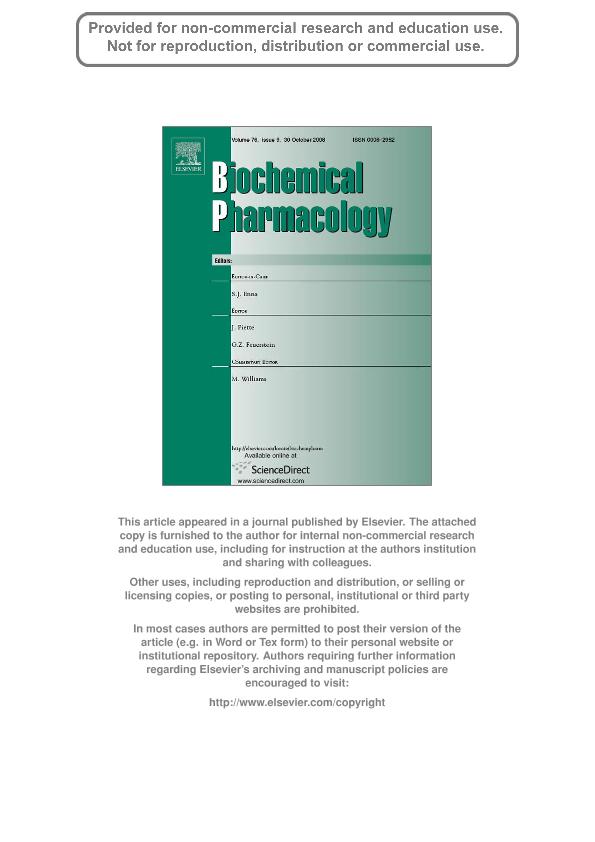Mostrar el registro sencillo del ítem
dc.contributor.author
Bussmann, Ursula Agnes

dc.contributor.author
Barañao, Jose Lino Salvador

dc.date.available
2017-09-29T19:33:09Z
dc.date.issued
2008-10
dc.identifier.citation
Bussmann, Ursula Agnes; Barañao, Jose Lino Salvador; Interaction between the aryl hydrocarbon receptor and transforming growth factor-beta signaling pathways: evidence of an asymmetrical relationship in rat granulosa cells; Elsevier; Biochemical Pharmacology; 76; 9; 10-2008; 1165-1174
dc.identifier.issn
0006-2952
dc.identifier.uri
http://hdl.handle.net/11336/25464
dc.description.abstract
The aryl hydrocarbon receptor (AHR) mediates toxic responses to environmental contaminants and plays pivotal physiological roles in various biological processes as well, particularly in ovarian function. It is well documented that expression and function of the AHR is negatively regulated by transforming growth factor-beta (TGF-beta) in many cell types. In addition, several studies indicate that AHR activity inhibits TGF-beta expression and function in some systems. However, the interplay between these two signals is highly dependent upon the cell type being studied, precluding a generalization about the outcome of such interaction. Therefore, the goal of the present study was to determine the effect of TGF-beta on AHR expression and activation in granulosa cells, an ovarian cell type where the growth factor is mitogenic and AHR activation has been associated with promotion of proliferation as well. In addition, we conducted experiments aimed at evaluating the effect of AHR ligands on TGF-beta action in our system. Results presented herein demonstrate that AHR expression is not regulated by TGF-beta in rat granulosa cells, neither at the mRNA level nor at the protein level. Moreover, we find that the growth factor does not alter the transcriptional function of the AHR. Conversely, we show that activation of AHR by an agonist deregulates TGF-beta function in granulosa cells, inhibiting its transcriptional activity and its mitogenic action. The described one-sided interplay between TGF-beta and AHR signaling pathway may help provide a mechanistic explanation to some of the physiological outcomes of AHR or TGF-beta activation in granulosa cells.
dc.format
application/pdf
dc.language.iso
eng
dc.publisher
Elsevier

dc.rights
info:eu-repo/semantics/openAccess
dc.rights.uri
https://creativecommons.org/licenses/by-nc-nd/2.5/ar/
dc.subject
Aryl Hydrocarbon Receptor
dc.subject
Transforming Growth Factor Beta
dc.subject
Granulosa Cells
dc.subject
Beta Naphthoflavone
dc.subject
Proliferation
dc.subject.classification
Bioquímica y Biología Molecular

dc.subject.classification
Ciencias Biológicas

dc.subject.classification
CIENCIAS NATURALES Y EXACTAS

dc.title
Interaction between the aryl hydrocarbon receptor and transforming growth factor-beta signaling pathways: evidence of an asymmetrical relationship in rat granulosa cells
dc.type
info:eu-repo/semantics/article
dc.type
info:ar-repo/semantics/artículo
dc.type
info:eu-repo/semantics/publishedVersion
dc.date.updated
2017-09-25T18:30:09Z
dc.identifier.eissn
1873-2968
dc.journal.volume
76
dc.journal.number
9
dc.journal.pagination
1165-1174
dc.journal.pais
Países Bajos

dc.journal.ciudad
Amsterdam
dc.description.fil
Fil: Bussmann, Ursula Agnes. Consejo Nacional de Investigaciones Científicas y Técnicas. Instituto de Biología y Medicina Experimental. Fundación de Instituto de Biología y Medicina Experimental. Instituto de Biología y Medicina Experimental; Argentina
dc.description.fil
Fil: Barañao, Jose Lino Salvador. Consejo Nacional de Investigaciones Científicas y Técnicas. Instituto de Biología y Medicina Experimental. Fundación de Instituto de Biología y Medicina Experimental. Instituto de Biología y Medicina Experimental; Argentina. Universidad de Buenos Aires. Facultad de Ciencias Exactas y Naturales; Argentina
dc.journal.title
Biochemical Pharmacology

dc.relation.alternativeid
info:eu-repo/semantics/altIdentifier/url/http://www.sciencedirect.com/science/article/pii/S0006295208005625
dc.relation.alternativeid
info:eu-repo/semantics/altIdentifier/doi/http://dx.doi.org/10.1016/j.bcp.2008.08.019
dc.relation.alternativeid
info:eu-repo/semantics/altIdentifier/pmid/18786509
Archivos asociados
